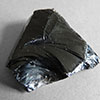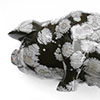- sale
- new items
- lovely beads
- wedding beads
- beads for teens
- for custom order
- newsletter
- recognition
- testimonials
- birthstones
- zodiac signs
- jewelry guide
SHOP BAG
![]() in your bag 0 items
in your bag 0 items
Obsidian is the rock formed when lava extruded from a volcano quickly cools without crystal growth. Thus, lava is the parent material and obsidian is a naturally occurring volcanic glass. Obsidian has been known since prehistoric times. The translation into English of Natural History written by Pliny the Elder shows a few sentences on the subject of a volcanic glass called Obsian, so named from its resemblance to a stone found in Ethiopia by Obsius, a Roman explorer.
Obsidian is mineral-like, but not a true mineral because as a glass it is not crystalline; in addition, its composition is too complex to comprise a single mineral. It is sometimes classified as a mineraloid. Pure obsidian is usually dark in appearance, though the color varies depending on the presence of impurities; iron and magnesium typically give the obsidian a dark brown to black color. In some stones, the inclusion of small, white, radially clustered crystals of cristobalite in the black glass produce a blotchy or snowflake pattern, and this is known in the gem trade as snowflake obsidian.
Obsidian has some fascinating properties as well as some important practical uses. It's hard and brittle; it therefore fractures with very sharp edges, which were used in the past in cutting and piercing tools, and it has been used experimentally as surgical scalpel blades. Well-crafted obsidian blades have a cutting edge many times sharper than high-quality steel surgical scalpels.
The first known archaeological evidence of usage dated 700,000 BC were made in Kenya. The first attested civilized use is from excavations in Syria dated the late fifth millennia. Obsidian was valued in Stone Age cultures because of its cutting properties, it was also polished to create early mirrors. Obsidian was also used in ritual circumcisions because of its deftness and sharpness and for ornamental purposes and as a gemstone.
Pre-Columbian Mesoamericans' use of obsidian was extensive and sophisticated; including carved and worked obsidian for tools and decorative objects. Mesoamericans also made a type of sword with obsidian blades mounted in a wooden body. Called "macuahuitl", the weapon was capable of inflicting terrible injuries, combining the sharp cutting edge of an obsidian blade with the ragged cut of a serrated weapon. Native American people traded obsidian throughout the Americas.
Obsidian can be found in locations which have experienced volcano eruptions. It can be found in Argentina, Armenia, Azerbaijan, Australia, Canada, Chile, Georgia, Greece, Salvador, Guatemala, Iceland, Italy, Japan, Kenya, Mexico, New Zealand, Papua New Guinea, Peru, Scotland, Turkey and the United States. Obsidian flows which may be hiked on are found in the Cascade Range of western North America, and in the Sierra Nevada in California. Yellowstone National Park has a mountainside containing obsidian, and deposits can be found in many other western states in USA.



